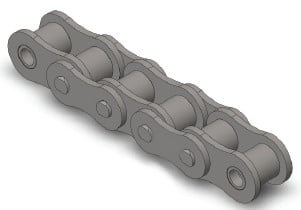The next measures ought to be utilised to pick chain and sprocket sizes, decide the minimum center distance, and calculate the length of chain desired in pitches. We’ll generally use Imperial units (such as horsepower) within this section nonetheless Kilowatt Capacity tables are available for every chain size inside the preceding segment. The variety strategy is definitely the identical irrespective of your units made use of.
Step 1: Decide the Class of your Driven Load
Estimate which of your following best characterizes the situation from the drive.
Uniform: Smooth operation. Minor or no shock loading. Soft start up. Moderate: Usual or moderate shock loading.
Heavy: Significant shock loading. Frequent begins and stops.
Phase two: Ascertain the Services Aspect
From Table 1 below figure out the suitable Services Issue (SF) to the drive.
Stage 3: Calculate Design Electrical power Necessity
Design and style Horsepower (DHP) = HP x SF (Imperial Units)
or
Style and design Kilowatt Energy (DKW) = KW x SF (Metric Units)
The Design and style Electrical power Requirement is equal for the motor (or engine) output electrical power occasions the Service Issue obtained from Table 1.
Step four: Make a Tentative Chain Variety
Create a tentative choice of the demanded chain size from the following method:
one. If applying Kilowatt power – fi rst convert to horsepower for this phase by multiplying the motor Kilowatt rating by 1.340 . . . This is vital since the swift selector chart is proven in horsepower.
2. Locate the Style and design Horsepower calculated in step three by studying up the single, double, triple or quad chain columns. Draw a horizontal line through this value.
three. Locate the rpm of  the little sprocket within the horizontal axis from the chart. Draw a vertical line by this worth.
the little sprocket within the horizontal axis from the chart. Draw a vertical line by this worth.
four. The intersection of your two lines should indicate the tentative chain choice.
Stage five: Choose the amount of Teeth to the Compact Sprocket
The moment a tentative selection of the chain dimension is produced we have to decide the minimum amount of teeth demanded around the smaller sprocket demanded to transmit the Design Horsepower (DHP) or the Layout Kilowatt Power (DKW).
Stage six: Determine the number of Teeth for your Large Sprocket
Make use of the following to determine the amount of teeth for that big sprocket:
N = (r / R) x n
The quantity of teeth on the significant sprocket equals the rpm from the compact sprocket (r) divided from the desired rpm from the huge sprocket (R) times the amount of teeth over the small sprocket. When the sprocket is too huge for that room obtainable then several strand chains of a smaller pitch need to be checked.
Phase seven: Determine the Minimum Shaft Center Distance
Use the following to calculate the minimum shaft center distance (in chain pitches):
C (min) = (2N + n) / six
The over is a manual only.
Phase eight: Verify the Final Selection
On top of that be aware of any probable interference or other area limitations that could exist and adjust the assortment accordingly. Generally the most efficient/cost eff ective drive employs single strand chains. This really is since multiple strand sprockets are more highly-priced and as is usually ascertained from the multi-strand variables the chains develop into less effi cient in transmitting electrical power as the amount of strands increases. It is as a result generally best to specify single strand chains when feasible
Step 9: Ascertain the Length of Chain in Pitches
Make use of the following to determine the length with the chain (L) in pitches:
L = ((N + n) / two) + (2C) + (K / C)
Values for “K” can be found in Table 4 on web page 43. Don’t forget that
C could be the shaft center distance given in pitches of chain (not inches or millimeters and so forth). In the event the shaft center distance is acknowledged inside a unit of length the worth C is obtained by dividing the chain pitch (during the same unit) through the shaft centers.
C = Shaft Centers (inches) / Chain Pitch (inches)
or
C = Shaft Centers (millimeters) / Chain Pitch (millimeters)
Note that every time achievable it really is very best to make use of an even number of pitches so that you can avoid using an off set link. Off sets never possess exactly the same load carrying capacity because the base chain and ought to be prevented if feasible.